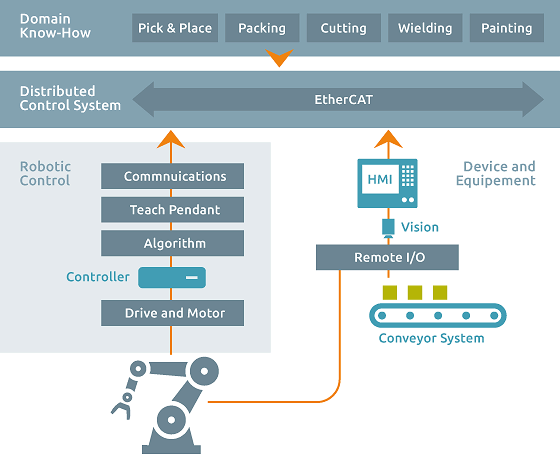Robot Control Solution
Smart Manufacturing
Robotics is a perfect example of the move to computerize industrial manufacturing and the smart factory vision put forward by Industry 4.0 and the Internet of Things (IoT). Almost all aspects are digitized, spanning machine control, monitoring, management, and data reporting and analysis. Even operators interact with machines digitally using a human machine interface (HMI). The smart factory provides many benefits, including a reduction in operator hours and opportunities to increase throughput, boost yields, improve efficiency, and reduce downtime through insights gained from advanced data analytics.
Simplifying the Design of Robotic Systems
Robotics are playing a major role in making manufacturing processes more productive and less labor intensive, which is especially important in China, where there is a labor shortage in some regions. But impeding many manufacturers is the complexity of robotic system design, which is made more difficult by the need to identify and integrate subsystems from multiple vendors.
Greatly simplifying the robotic design process, NEXCOM, working closely with various solution providers, developed open modular solutions for a range of robotics applications. With pre-integrated and pre-validated robotic control modules, NEXCOM robot solution NexROBO performs precise robotics control and runs essential industrial application software.
Although industrial robotics systems come in all shapes and sizes, they will typically include the types of subsystems shown in Figure 1 and described in the following:
 |
| Figure 1. Typical robotic system components |
Robot Body
Made of high-strength materials and designed for harsh environments, the robot body plays a "hands on" role in the manufacturing of goods by performing tasks, such as welding, painting, packaging, inspecting, etc.
Robotic Control
Robot control systems are typically responsible for sensing, motor driving, and movement functions that require sophisticated algorithms. The design of these rather complicated systems also requires vast experience in remote teaching, application know-how, and networking technology suited to industrial environments (e.g., EtherCAT). Control system components may include:
- Controller: PC-based system controlling the robot body.
- Algorithms: Application software running on the controller.
- Teach Pendant: Input device (HMI) enabling process control customization.
- Communications: Devices supporting advanced communications capabilities (e.g., EtherCAT).
Devices and Equipment
In addition to the robotics, other systems are needed to complete the production line, and some examples are:
- Remote I/O: Peripheral devices communicating with sensors, actuators, networks, etc.
- Vision Inspection: Cameras capturing images for pattern checking, barcode scanning, defect inspection, measurement, etc.
- HMI: Panel PCs enabling operators to interact with the production equipment.
- Conveying System: A variety of equipment for moving goods along the production line.
Distributed Control System
This architecture is used to flexibly connect distributed I/Os, sensors, and drives so developers can implement robot design without concern for signal wiring length limitations.
Domain Know-How
In addition to robotics, production lines may require special functions that require particular expertise.
Modular and Open Robot Solution
A robotic production line involves many aspects beyond the robots, some of which can be challenging. There are actuation controls, sensing, data processing, and operational intelligence that may present issues around system integration, machine-to-machine communication, and information integration. Taken a step further, smart manufacturing based on IoT, smart robots, cyber-physical systems, and big data technologies introduce additional layers of complexity. The complexity can be greatly reduced by the modular design of industrial robots, which fits different application requirements. The below reference table illustrates key components of pre-integrated and pre-validated robotic NexROBO solutions carried by NEXCOM. Each application requires different levels of customization to fulfill application goals.
Robot Application
|
Subsystem |
Component | Auto Pasting Machine | Assembly Line | Industrial Robot Building | Academy Robot Development Platform |
|
Domain Know-How |
Auto Giving and Paste |
Pick and Place |
Robotic |
|
|
|
Robot Body |
Hiwin |
HIWIN |
3rd-party |
HIWIN |
|
|
Robotic Control |
Controller |
NEXCOM |
NEXCOM |
NEXCOM |
NEXCOM |
|
Algorithm |
NEXCOM |
NEXCOM |
Customer's |
NEXCOM |
|
|
Communications |
EtherCAT |
EtherCAT |
Third-party |
EtherCAT |
|
|
Device and Equipment |
Application Specific |
Conveying System |
Conveying System |
N/A |
N/A |
|
HMI |
NEXCOM |
NEXCOM |
Teach Pendant |
Customer's |
|
|
Remote I/O |
NEXCOM |
VIPA SLIO |
N/A |
NEXCOM |
- Related Products
- Delta Robot Solution IPPC 1640P NISE 105 Articulated Robot Solution SCARA Robot Solution
